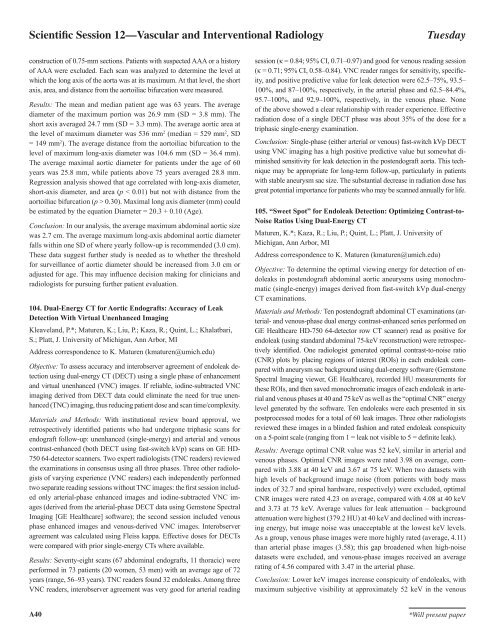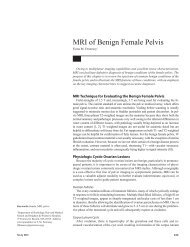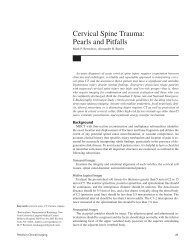Scientific Session 1 â Breast Imaging: Mammography
Scientific Session 1 â Breast Imaging: Mammography
Scientific Session 1 â Breast Imaging: Mammography
You also want an ePaper? Increase the reach of your titles
YUMPU automatically turns print PDFs into web optimized ePapers that Google loves.
<strong>Scientific</strong> <strong>Session</strong> 12—Vascular and Interventional RadiologyTuesdayconstruction of 0.75-mm sections. Patients with suspected AAA or a historyof AAA were excluded. Each scan was analyzed to determine the level atwhich the long axis of the aorta was at its maximum. At that level, the shortaxis, area, and distance from the aortoiliac bifurcation were measured.Results: The mean and median patient age was 63 years. The averagediameter of the maximum portion was 26.9 mm (SD = 3.8 mm). Theshort axis averaged 24.7 mm (SD = 3.3 mm). The average aortic area atthe level of maximum diameter was 536 mm 2 (median = 529 mm 2 , SD= 149 mm 2 ). The average distance from the aortoiliac bifurcation to thelevel of maximum long-axis diameter was 104.6 mm (SD = 36.4 mm).The average maximal aortic diameter for patients under the age of 60years was 25.8 mm, while patients above 75 years averaged 28.8 mm.Regression analysis showed that age correlated with long-axis diameter,short-axis diameter, and area (p < 0.01) but not with distance from theaortoiliac bifurcation (p > 0.30). Maximal long axis diameter (mm) couldbe estimated by the equation Diameter = 20.3 + 0.10 (Age).Conclusion: In our analysis, the average maximum abdominal aortic sizewas 2.7 cm. The average maximum long-axis abdominal aortic diameterfalls within one SD of where yearly follow-up is recommended (3.0 cm).These data suggest further study is needed as to whether the thresholdfor surveillance of aortic diameter should be increased from 3.0 cm oradjusted for age. This may influence decision making for clinicians andradiologists for pursuing further patient evaluation.104. Dual-Energy CT for Aortic Endografts: Accuracy of LeakDetection With Virtual Unenhanced <strong>Imaging</strong>Kleaveland, P.*; Maturen, K.; Liu, P.; Kaza, R.; Quint, L.; Khalatbari,S.; Platt, J. University of Michigan, Ann Arbor, MIAddress correspondence to K. Maturen (kmaturen@umich.edu)Objective: To assess accuracy and interobserver agreement of endoleak detectionusing dual-energy CT (DECT) using a single phase of enhancementand virtual unenhanced (VNC) images. If reliable, iodine-subtracted VNCimaging derived from DECT data could eliminate the need for true unenhanced(TNC) imaging, thus reducing patient dose and scan time/complexity.Materials and Methods: With institutional review board approval, weretrospectively identified patients who had undergone triphasic scans forendograft follow-up: unenhanced (single-energy) and arterial and venouscontrast-enhanced (both DECT using fast-switch kVp) scans on GE HD-750 64-detector scanners. Two expert radiologists (TNC readers) reviewedthe examinations in consensus using all three phases. Three other radiologistsof varying experience (VNC readers) each independently performedtwo separate reading sessions without TNC images: the first session includedonly arterial-phase enhanced images and iodine-subtracted VNC images(derived from the arterial-phase DECT data using Gemstone Spectral<strong>Imaging</strong> [GE Healthcare] software); the second session included venousphase enhanced images and venous-derived VNC images. Interobserveragreement was calculated using Fleiss kappa. Effective doses for DECTswere compared with prior single-energy CTs where available.Results: Seventy-eight scans (67 abdominal endografts, 11 thoracic) wereperformed in 73 patients (20 women, 53 men) with an average age of 72years (range, 56–93 years). TNC readers found 32 endoleaks. Among threeVNC readers, interobserver agreement was very good for arterial readingsession (κ = 0.84; 95% CI, 0.71–0.97) and good for venous reading session(κ = 0.71; 95% CI, 0.58–0.84). VNC reader ranges for sensitivity, specificity,and positive predictive value for leak detection were 62.5–75%, 93.5–100%, and 87–100%, respectively, in the arterial phase and 62.5–84.4%,95.7–100%, and 92.9–100%, respectively, in the venous phase. Noneof the above showed a clear relationship with reader experience. Effectiveradiation dose of a single DECT phase was about 35% of the dose for atriphasic single-energy examination.Conclusion: Single-phase (either arterial or venous) fast-switch kVp DECTusing VNC imaging has a high positive predictive value but somewhat diminishedsensitivity for leak detection in the postendograft aorta. This techniquemay be appropriate for long-term follow-up, particularly in patientswith stable aneurysm sac size. The substantial decrease in radiation dose hasgreat potential importance for patients who may be scanned annually for life.105. “Sweet Spot” for Endoleak Detection: Optimizing Contrast-to-Noise Ratios Using Dual-Energy CTMaturen, K.*; Kaza, R.; Liu, P.; Quint, L.; Platt, J. University ofMichigan, Ann Arbor, MIAddress correspondence to K. Maturen (kmaturen@umich.edu)Objective: To determine the optimal viewing energy for detection of endoleaksin postendograft abdominal aortic aneurysms using monochromatic(single-energy) images derived from fast-switch kVp dual-energyCT examinations.Materials and Methods: Ten postendograft abdominal CT examinations (arterial-and venous-phase dual energy contrast-enhanced series performed onGE Healthcare HD-750 64-detector row CT scanner) read as positive forendoleak (using standard abdominal 75-keV reconstruction) were retrospectivelyidentified. One radiologist generated optimal contrast-to-noise ratio(CNR) plots by placing regions of interest (ROIs) in each endoleak comparedwith aneurysm sac background using dual-energy software (GemstoneSpectral <strong>Imaging</strong> viewer, GE Healthcare), recorded HU measurements forthese ROIs, and then saved monochromatic images of each endoleak in arterialand venous phases at 40 and 75 keV as well as the “optimal CNR” energylevel generated by the software. Ten endoleaks were each presented in sixpostprocessed modes for a total of 60 leak images. Three other radiologistsreviewed these images in a blinded fashion and rated endoleak conspicuityon a 5-point scale (ranging from 1 = leak not visible to 5 = definite leak).Results: Average optimal CNR value was 52 keV, similar in arterial andvenous phases. Optimal CNR images were rated 3.98 on average, comparedwith 3.88 at 40 keV and 3.67 at 75 keV. When two datasets withhigh levels of background image noise (from patients with body massindex of 32.7 and spinal hardware, respectively) were excluded, optimalCNR images were rated 4.23 on average, compared with 4.08 at 40 keVand 3.73 at 75 keV. Average values for leak attenuation – backgroundattenuation were highest (379.2 HU) at 40 keV and declined with increasingenergy, but image noise was unacceptable at the lowest keV levels.As a group, venous phase images were more highly rated (average, 4.11)than arterial phase images (3.58); this gap broadened when high-noisedatasets were excluded, and venous-phase images received an averagerating of 4.56 compared with 3.47 in the arterial phase.Conclusion: Lower keV images increase conspicuity of endoleaks, withmaximum subjective visibility at approximately 52 keV in the venousA40*Will present paper
















